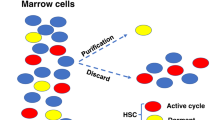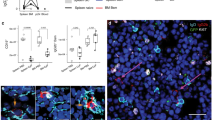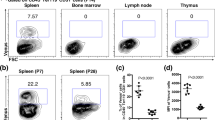Abstract
APPRECIABLE numbers of lymphocyte-like cells are found in the bone marrow of mice1,2 and other mammals3,4. Their origin has intrigued investigators for many years3. Yoffey3,4 considers that these cells have a haematogeneous origin, while Osmond and Everett5 find no evidence for the influx into the bone marrow of large numbers of blood lymphocytes. Evidence is accumulating that mitochon-drial content is a useful criterion for characterization of lymphocytes6–9 and that electron microscopy may help to elucidate the origin of some lymphocyte-like cells8. The present investigation was undertaken to compare the number of mitochondria in lymphocytes from blood and lymphocyte-like cells in bone marrow and to examine the ultrastructure of the latter.
This is a preview of subscription content, access via your institution
Access options
Subscribe to this journal
Receive 51 print issues and online access
$199.00 per year
only $3.90 per issue
Buy this article
- Purchase on Springer Link
- Instant access to full article PDF
Prices may be subject to local taxes which are calculated during checkout
Similar content being viewed by others
References
Endicott, K. M., and Gump, H., in Morphologic Hematology, Special Issue No. 1 of Blood, The Journal of Hematology (edit. by Dameshek, W.) (Grune and Stratton, New York, 1947).
Cudkowicz, G., Bennett, M., and Shearer, G. M., Science, 144, 866 (1964).
Yoffey, J. M., and Courtice, F. C., in Lymphatics, Lymph and Lymphoid Tissue, 336, 417, 422 (Harvard University Press, Cambridge, Massachusetts, 1956).
Yoffey, J. M., in Quantitative Cellular Hematology, 1 (Chas. C. Thomas, Springfield, Illinois, 1960).
Osmond, D. G., and Everett, N. B., Blood, 23, 1 (1964).
Fichtelius, K. E., and Larsson, S. E., Acta Anat., 44, 60 (1961).
Ernstrom, U., and Larsson, B., Acta Pathol. et Microbiol. Scand., 59, 304 (1963).
Albert, S., Wolf, P. L., Loud, A. V., Pryjma, I., Potter, R., and Moore, W., J. Reticuloendothelial Soc., 3, 176 (1966).
Albert, S., Wolf, P. L., and Moore, W., J. Reticuloendothelial Soc., 2, 218 (1965).
Mood, A. M., and Graybill, F. A., in Introduction to the Theory of Statistics, second ed., 72, 275 (McGraw-Hill Book Co., Inc., New York, 1963).
Croxton, F. E., in Elementary Statistics in Medicine and the Biological Sciences, 59 (Dover Publications, Inc., New York, 1953).
Albert, S., Wolf, P. L., and Pryjma, I., J. Reticuloendothelial Soc., 2, 30 (1965).
Albert, S., Wolf, P. L., Pryjma, I., and Vazquez, J., J. Reticuloendothelial Soc., 2, 158 (1965).
Albert, S., Wolf, P. L., Pryjma, I., and Vazquez, J., Amer. J. Clin. Path., 45, 460 (1966).
Author information
Authors and Affiliations
Rights and permissions
About this article
Cite this article
ALBERT, S., WOLF, P. & POTTER, R. Observations on the Origin of Lymphocyte-like Cells in Mouse Bone Marrow. Nature 212, 1577–1579 (1966). https://doi.org/10.1038/2121577a0
Published:
Issue Date:
DOI: https://doi.org/10.1038/2121577a0
This article is cited by
Comments
By submitting a comment you agree to abide by our Terms and Community Guidelines. If you find something abusive or that does not comply with our terms or guidelines please flag it as inappropriate.



